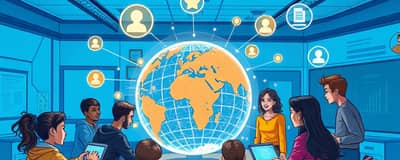In an era defined by rapid technological advancement, ensuring every student has the tools and skills to thrive is more critical than ever. Digital literacy and reliable internet access have become fundamental components of modern education, yet millions of children remain on the wrong side of this divide. This article explores the roots of unequal digital access, its profound impact on learning and opportunity, and the strategies that can forge a path toward lasting equity.
Defining Digital Equity and the Digital Divide
Digital equity extends beyond mere device ownership. It encompasses sustainable, tech-rich learning environments, ongoing technical support, and the instruction necessary to leverage technology effectively. When students lack these resources, they struggle to complete assignments, collaborate with peers, and develop the skills demanded by tomorrow’s workforce.
The digital divide manifests in stark statistics: about 13.5 million U.S. school-aged children lack adequate broadband or a web-enabled device, and nearly 25% of students cannot access full high-speed internet at home. Disparities deepen along lines of race, income, and geography, creating systemic barriers that threaten to lock generations into cycles of limited opportunity.
The Impact of Unequal Access on Students
Students without reliable devices and connectivity face academic setbacks from the outset. Homework remains incomplete, research projects stall, and online collaboration becomes a frustrating ordeal. Disproportionately affect marginalized and low-income students, these obstacles compound, leading to lower test scores, reduced graduation rates, and diminished confidence.
Moreover, digital inequity erodes future prospects. In a job market increasingly centered on technology, students must not only consume digital content but also create and innovate. Those without early exposure to coding, multimedia tools, and virtual collaboration find themselves at a disadvantage when applying to colleges or competing for internships.
Key Statistics at a Glance
Accelerating Factors: Technology Growth and the Pandemic
The COVID-19 pandemic shone a harsh spotlight on the digital divide. As classrooms went virtual, schools and families scrambled to secure devices and internet connections. Temporary measures—like free hotspot distributions and emergency funding—helped bridge immediate gaps, but these solutions often lacked long-term sustainability.
Meanwhile, the pace of technological innovation has only accelerated. From virtual reality labs to AI-driven tutors, learning tools are becoming more sophisticated. Without deliberate efforts to keep all students connected, primary barrier to education equity risks widening even further as new platforms and resources emerge.
National and Regional Disparities
Access to digital resources varies dramatically across states and communities. Mississippi, Arkansas, and New Mexico report the highest shares of students lacking both broadband and a computing device. In contrast, urban centers frequently boast higher connectivity rates and better-funded schools.
Efforts in Phoenix, Arizona and Brownsville, Texas demonstrate how targeted interventions can move the needle. Phoenix connected 250,000 families to high-speed internet, while Brownsville’s $20 million public-private partnership added 95 miles of fiber infrastructure. Such models offer valuable lessons for other regions seeking to close persistent gaps.
Interventions and Solutions
Achieving true digital equity requires holistic approaches: infrastructure, affordability, and education. Policymakers, educators, and community leaders must coordinate on multiple fronts:
- Federal and state emergency funding programs that extend beyond pandemic relief
- Public-private partnerships to expand broadband infrastructure in underserved areas
- Device donation drives coupled with subsidized service plans for low-income families
- Comprehensive digital literacy training for students, parents, and educators
Emerging initiatives, like state broadband offices and federal connectivity funds, provide blueprints for scalable, sustainable progress. Yet success hinges on continuous evaluation and adaptation as technology and community needs evolve.
Ongoing Challenges and the Path Forward
Despite promising gains, significant hurdles remain. Affordability concerns persist as service costs rise and devices age. Digital literacy programs require consistent funding and skilled trainers. Furthermore, as AI and advanced technologies reshape classrooms, students must be prepared for future-ready, tech-driven environments.
Long-term success demands an equity-centered mindset: one that views every student as a stakeholder in the digital ecosystem. By embedding digital equity into education policy, investing in robust infrastructure, and nurturing an inclusive culture of technology use, we can ensure that every learner is equipped to participate fully in a 21st-century landscape.
Conclusion
The digital divide stands as one of the greatest challenges—and opportunities—of our time. Bridging this gap is not merely an educational imperative but a moral one. With coordinated action spanning government agencies, school systems, businesses, and communities, we can transform digital equity from an aspiration into a reality. By nurturing prepare students for a tech-driven society, we lay the groundwork for a more just, prosperous future—one in which every child, regardless of zip code or background, can unlock their full potential.
References
- https://nces.ed.gov/forum/digitalequity_chapter3.asp
- https://west.edtrust.org/resource/education-equity-in-crisis-the-digital-divide/
- https://www.isocfoundation.org/2023/06/what-is-digital-equity/
- https://soeonline.american.edu/blog/digital-divide-in-education/
- https://leadershipblog.act.org/2024/07/digital-divide-research.html
- https://thehyperstack.com/blog/ensuring-digital-equity-bridging-the-gap-in-online-education/
- https://all4ed.org/digital-equity-access-and-opportunity-in-the-digital-age/














